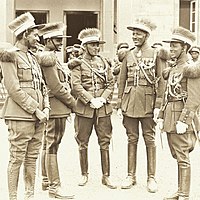Kebur Zabagna
| Kebur Zabagna | |
|---|---|
 Members of the Ethiopian Kebur Zabagna | |
| Active | 1917–1936 1941–1974 |
| Country | |
| Branch | Army |
| Type | Imperial guard Infantry |
| Size | 9 Battalions |
| Garrison/HQ | Addis Ababa |
| Patron | Emperor of Ethiopia |
| Engagements | |
| Commanders | |
| Ceremonial chief | Emperor of Ethiopia |
TheKebur Zebenya(Amharic:ክቡር ዘበኛ,romanized:kəbur zãbãňňya,lit. 'honorable guard') was theEthiopianimperial guard.Also known as theFirst Division,this unit served the dual purposes of providing security for theEmperor of Ethiopia,and being an elite infantrydivision.It was not, however, part of the organizational structure of theEthiopian regular armyas it was part of theZebagna,theAddis AbabaGuard. The Kebur Zabagna was based inAddis Ababa.
History[edit]
Establishment[edit]
Richard Pankhurstdates the formation of the Imperial Bodyguard (previously known as theMehal Sefari) to 1917, when the RegentRasTafari (later the EmperorHaile Selassie) assembled a unit under his direct control from men who had trained in the British army inKenyaas well as a few who had served under the Italians inTripoli.[1]In 1930 asNegushe invited aBelgian military missionto train and modernize the Ethiopian military, which included the Kebur Zabagna. The unit was organized in three battalions of trained regular infantry armed with rifles, machine guns and mortars; one battalion consisted of men from the earliermahal safari.The Kebur Zabagna also had oneheavy machine guncompany. It was commanded by Ethiopian graduates ofSaint Cyr,the French military academy, at the time of theItalian invasion of Ethiopia.[2]
Italian occupation[edit]
As a unit, the Imperial Bodyguard only participated in theBattle of Maychew(31 March 1936), where they inflicted heavy losses on the2nd Eritrean Divisionuntil the Ethiopian troops were forced to withdraw; the Imperial Guard thereafter served in the rearguard. Afterward, many of its members joined the various groups of theEthiopian resistance.One of these was Kosrof Gorgorios Boghossian, a colonel in the Kebur Zabagna and ofArmeniandescent, who was the father of noted artistSkunder Boghossian[3][4]
Post-occupation[edit]

Following the return of Emperor Haile Selassie to Ethiopia, the Kebur Zabagna was reconstituted, and aSwedish military missionaided in its training. Men for theKagnew Battalion,which fought in theKorean War,were drawn from the Imperial Bodyguard.[5]During the Korean War they were armed with American weapons which included theM1 Garand.30-06,M1 carbine.30and some hadM1911.45 ACPpistols.
"It remained the elite force of the empire," notes historian Bahru Zewde, "until discredited in the wake of theattempted coup of 1960."That unsuccessful coup had been planned by its commander Brigadier-GeneralMengistu Neway,and his brotherGermame Neway.[6]In 1961 it numbered ninebattalions;in 1969 some 7,000 men.
During the state visits ofElizabeth IIandMohammad Reza Pahlavito Ethiopia, Emperor Hail Selassie's Silver Jubilee Golden State Carriage was drawn by team from the Imperial Guard onhorsebackin red and green uniforms.[7]
The Kebur Zabagna was disbanded after theDergconsolidated their hold on Ethiopia.
Imperial Bodyguard Band[edit]
The first permanentmilitary bandin the country to be established the Imperial Bodyguard Band in 1929 under the direction of Swiss conductor Andre Nicod. It was notable for its implementation of western style military music conventions in a first for anyAfricannation.[8]
Notable members of the Kebur Zabagna[edit]
Commanders[edit]
- GeneralMulugeta Buli(1941-1955)
- Brigadier-GeneralMengistu Neway(April 1956-13 December 1960)
- Major-GeneralTafessa Lemma(1974)
Soldiers[edit]
- Abebe Bikila,professional athlete and member of the5th Infantry Regiment.
- Fisseha Desta,firstVice President of Ethiopiafrom 1987 to 1991.
Bandsmen[edit]
- Tilahun Gessesse[9]
- Mahmoud Ahmed.[10][11]
- Alexander Kontorowicz
Notes[edit]
- ^Pankhurst, Richard (1968).Economic History of Ethiopia, 1800–1935.Addis Ababa: Haile Sellassie I University Press. p. 562.
- ^Bahru Zewde,A History of Modern Ethiopia,second edition (Oxford: James Currey, 2001), p. 148
- ^Adejumobi, Saheed A. (2006).The History of Ethiopia.Greenwood Press. p. 167.ISBN978-0313322730.
- ^Legesse, Selamawit (2005)."Skunderism (The Third Annual Blen Art Show)".Blen.Retrieved16 October2010.
- ^Bahru Zewde,A History,p. 186, and Fantahun Ayele, "The Ethiopian Army: from Victory to Collapse 1977–91, Evanston,Northwestern University Press,2014, 12.[ISBN missing]
- ^Paul B. Henze,Layers of Time(New York: Palgrave, 2000), pp. 254f.[ISBN missing]
- ^Observer, Ethiopia (9 September 2022)."Prince Asfa-Wossen Asserate recalls Queen Elizabeth II's Ethiopia visit".Ethiopia Observer.Retrieved21 May2023.
- ^Kidane, Birhane (1993). The Origin and Development of the Imperial Guard Band (1924–1974). B.A. Thesis, Department of History, Addis Ababa University.
- ^"Tilahun Gessesse laid to rest".Ethiopian News Agency. 23 April 2009. Archived fromthe originalon 25 April 2009.Retrieved23 April2009.
- ^Falceto, Francis(1999).Almaz 1973(Media notes).Éthiopiques.Mahmoud Ahmed. Buda Musique. 829792.
- ^Mekonnen, Timkehet Teffera."Timkehet Teffera (2018). Ethiopian Popular Music History Chapter I: Part II".
